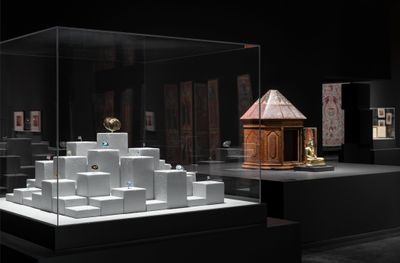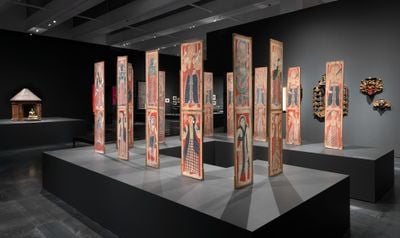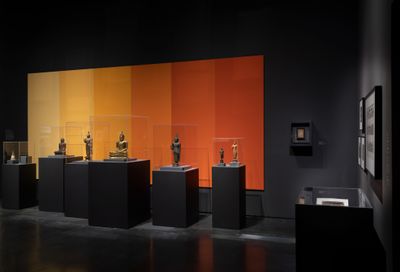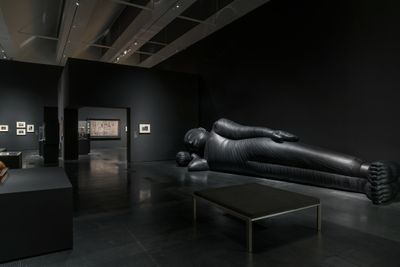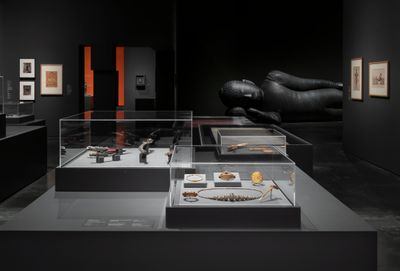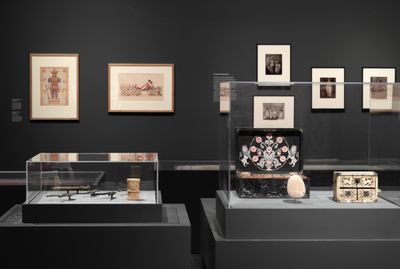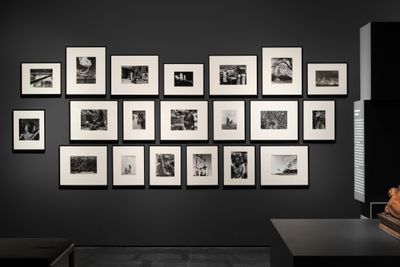The Jeweled Isle: Art from Sri Lanka at LACMA
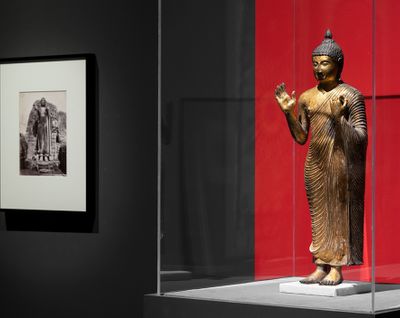
Exhibition view: The Jeweled Isle: Art from Sri Lanka, Los Angeles County Museum of Art (9 December 2018–23 June 2019). Courtesy Los Angeles County Museum of Art. Photo: © Museum Associates/LACMA.
The Jeweled Isle: Art from Sri Lanka at the Los Angeles County Museum of Art (9 December 2018–23 June 2019) is billed as the first comprehensive survey of Sri Lankan art organised by a U.S. museum, with around 240 works—including decorative objects, textiles, photographs, and historical works from the museum's own collection of Sri Lankan art—covering nearly two millennia. This wildly ambitious exhibition—whose curatorial statement claims to address nearly all Sri Lankan art from within the covered frame—is vaguely organised around three chronological sections, each according to the site of a major Sri Lankan capital city: Anuradhapura, the capital city of North Central Province (3rd century BCE–10th century CE), Polonnaruwa, once the seat of the Kingdom of Polonnaruwa (11th–13th century), and Kandy, the capital of the Central Province (15th–19th century). The show's title draws from the ancient Sanskrit and Greco-Roman texts and historical travel accounts that mention the island's abundance of precious gems and its tropical environment.
The exhibit is organised by Dr Robert L. Brown, curator in the South and Southeast Asian Art Department at LACMA and professor of Indian and Southeast Asian Art at UCLA, and Dr Tushara Bindu Gude, associate curator in the South and Southeast Asian Art Department at LACMA. No objects came from Sri Lankan museums due to government restrictions there, with most drawn from public and private collections in the United States, a few loans from the Victoria and Albert Museum in London, and 90 objects sourced from LACMA's own collection.
As an art exhibition, The Jeweled Isle: Art from Sri Lanka functions more on ethnographic terms. Upon entering the Resnick Pavilion, one immediately notices a large glass case filled with 21 stones and jewels, ranging from rubies to sapphires and other precious and semi-precious gems—a demonstration of the show's title, if nothing else. Also included in this first sector are works varying from the 17th to 19th centuries, including masks, terracotta and earthenware objects; plus various silver prints depicting scenes and sites in Sri Lanka, including A Villager Selling Plantains from circa 1890 (photographer unknown), and A Coffee Tree in Blossom (c.1880), by Charles T. Scowen & Co.
Taking centre stage is an installation of 17th–18th century wooden architectural panels from a Buddhist temple, arranged on a platform in a configuration that can be entered, so that both sides of the panels can be viewed. These panels are painted on both sides, and it is likely that they were originally used as door or window shutters. Indicative of the exhibition's larger thematic focus on the island's religious history, illustrations decorating each panel are predominantly rendered in red and blue, with intricate, nearly psychedelic patterns providing a sense of phantasmagorical dimensionality. The upper register of each panel depicts a deity, including Buddhist divinities, Brahmanical gods, and the 'nine seizers' or navagrahas, who are known to connect planetary bodies with human fates in South Asian astrology. The presence of the latter entities in Hinduism, also worshipped albeit to different degrees, indicates the shared cultural concerns between Sri Lanka and India. The Brahmanical god Ganesha, believed to have the power to both remove and implement obstacles, is shown with an elephant head and a rat as his mount.
The religious theme continues throughout the exhibition, both through the objects on view and through the design of the show itself, which was overseen by Frank Escher and Ravi GuneWardena of Escher GuneWardena Architecture. Many of the objects on display are placed against dark grey walls or on dark grey pedestals to evoke the stone structures encountered in Sri Lanka's ancient architectural monuments, while a selection of religious objects—including images of Buddha, Christian devotional icons, and a Hindu sculpture—are placed against bright panels in shades of orange, red, and yellow that recall sacred or ritual pigments.
The dominant religion of Sri Lanka is Theravada Buddhism, which focuses on the Shakyamuni Buddha: the historical Buddha of the 6th century BCE. In the final section of the show, titled 'Buddhist Legacies and Island Memories', contemporary artist Lewis deSoto's massive inflatable sculpture Paranirvana (Self Portrait) (2015) depicts the Shakyamuni Buddha meditating in a reclining posture taken before his enlightenment. The work is influenced by a 12th-century rock sculpture of the same nature at the Gal Vihara temple in the ancient city of Polonnaruva, which is displayed for comparison via an exhibition print by British photographer Joseph Lawton from between 1870–1871, shown adjacent to deSoto's work. (The American artist's version replaces the Buddha's face with his own.)
According to its description, Paranirvana (Self Portrait) is meant to be 'active' or 'brought to life' when it is inflated or deflated with an industrial fan, thus mimicking repetitive spiritual breathing practices (known as prana) that reference the cycles of rebirth. An outlier work of contemporary art, deSoto's sculpture is a confusing but effective intervention in a show dominated by historical objects.
There is an abundance of archival photography throughout—mostly prints by British photographers, particularly from the late-19th century, including various images of the former royal gardens at Kandy by Charles Thomas Scowen, as well as silver-print portraits of Kandyan elites from his successful commercial company, Scowen & Co. Among those on display in the sector titled 'Sri Lanka and Europe' is Kandyan Chief (c.1870): an albumen silver print showcasing the fashions of a Kandyan chief adorned in ornate jewellery, and wearing the tupottiyal, a cloth wrapped around the hips that is fastened with a gold belt—typical court dress for men.
The visibility of such archive photographs in this exhibition serve as a constant reminder of Sri Lanka's colonised past; an attempt, perhaps, at dealing with the uncomfortable question of agency—and complicity—in a show like this, which maps a history of an island that was and has been shaped by the colonial gaze. The South Asian country was under European colonial rule for more than four hundred years, starting with the Portuguese in 1517—who exploited the rivalry between the ruling kingdoms of Jaffna, Kotte and Kandyas to expand their control, and ending with the British, from whom the island secured its independence in 1948. The implications of such enduring imperialist rule did not leave Sri Lanka's arts untouched, with many artists and artisans adapting their practice to suit international markets and audiences.
A direct—and refreshing—contrast to representations emanating from colonial eyes are the 20 striking gelatin silver prints by 20th-century photographer Reg van Cuylenburg, of Kandyan Sinhalese, English, and Dutch descent: a student of Sri Lankan modern master Lionel Wendt. Unlike the photographs throughout the exhibit that lean towards ethnography, van Cuylenburg's images neither attempt to define nor constrict explanations of cultural or religious traditions and histories for a European or Western audience. In Penitents Swinging on Hooks at Kataragama (1957), a Kataragama worshipper is surrounded by four men hoisting him up as he swings by hooks from a structure adorned with flowers, his hands in prayer formation held up to his forehead as he faces away from the camera. The photograph signifies a more sustained and levelled engagement between observer and the observed—the imposed gaze is impenetrable to the devotee absorbed in prayer.
Van Cuylenburg's images offer a productive counterpoint in an exhibition that presents itself as a 'comprehensive survey' of art from Sri Lanka over the course of 2,000 years—a way through the inescapable fact that all the objects on view were sourced from collections in the Western world. In her book For the Record: On Sexuality and the Colonial Archive in India, Anjali Arondekar describes the archive—broadly conceived—as 'a collection of knowledge(s) with no centre, except that 'something missing' needs to be continuously added.'[1] In The Jeweled Isle: Art from Sri Lanka, the centre remains, even if steps are being taken towards opening it up. —[O]
—
[1] Arondekar, Anjali. For the Record: On Sexuality and the Colonial Archive in India. Duke University Press, 2009, pp. 122.

